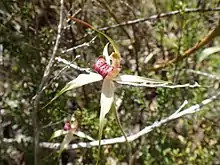| Robust spider orchid | |
|---|---|
 | |
| Caladenia valida growing near Victor Harbour | |
| Scientific classification | |
| Kingdom: | Plantae |
| Clade: | Tracheophytes |
| Clade: | Angiosperms |
| Clade: | Monocots |
| Order: | Asparagales |
| Family: | Orchidaceae |
| Subfamily: | Orchidoideae |
| Tribe: | Diurideae |
| Genus: | Caladenia |
| Species: | C. valida |
| Binomial name | |
| Caladenia valida | |
| Synonyms[1] | |
|
Caladenia reticulata var. valida Nicholls | |
Caladenia valida, commonly known as the robust spider orchid, is a plant in the orchid family Orchidaceae and is endemic to south-eastern continental Australia. It is a ground orchid with a single sparsely hairy leaf and up to three white to cream-coloured flowers which sometimes have red streaks. It is similar to Caladenia reticulata but is large and taller with more stiffly spreading lateral sepals and petals.
Description
Caladenia valida is a terrestrial, perennial, deciduous, herb with an underground tuber and a single sparsely hairy leaf, 100–150 mm long and 10–25 mm wide with red blotches near its base. One, two or three flowers up to 70 mm wide are borne on a hairy spike 200–400 mm high. The sepals have dark red, club-like glandular tips 3–5 mm long. The dorsal sepal is erect or curved forward, 35–50 mm long and about 3 mm wide. The lateral sepals are 35–50 mm long and about 4 mm wide and curve stiffly downwards. The petals are 35–45 mm long, 2–3 mm wide and curve downwards. The labellum is cream-coloured to white, 12–15 mm long, 9–11 mm wide with red markings. The sides of the labellum have reddish teeth up to 2 mm long, the tip of the labellum is curved downwards and there are four or six rows of reddish calli up to about 1 mm long, along its mid-line. Flowering occurs in September and October.[2][3][4][5]
Caladenia reticulata is similar and C. valida was originally described as a variety of it but is a larger, taller orchid with more stiffly spreading sepals and petals and is pollinated by different species of thynnid wasp - C. reticulata is pollinated by Phymatothynnus victor and C. valida by Phymatothynnus pygidialis.[3][5][6]
Taxonomy and naming
This orchid was first formally described in 1942 by William Henry Nicholls who gave it the name Caladenia reticulata var. valida. The type specimen was collected near Portland and the description was published in The Victorian Naturalist.[7][8] In 1989 Mark Clements and David Jones raised it to species status in Australian Orchid Research.[1] The specific epithet (valida) is a Latin word meaning "strong" or "powerful"[9] although Nicholls did not give a reason for applying this name.
Distribution and habitat
The robust spider orchid occurs in Victoria and South Australia where it grows in coastal, or near-coastal heath. In Victoria it grows near Portland and Anglesea and in South Australia on Kangaroo Island and southern Fleurieu Peninsula.[3][6]
Conservation
Caladenia valida is listed as "endangered" under the Victorian Government Flora and Fauna Guarantee Act 1988 and under the Government of South Australia National Parks and Wildlife Act 1972.[3][6]
References
- 1 2 3 "Caladenia valida". APNI. Retrieved 26 March 2017.
- ↑ Jones, David L. (2006). A complete guide to native orchids of Australia including the island territories. Frenchs Forest, N.S.W.: New Holland. p. 77. ISBN 1877069124.
- 1 2 3 4 Jeanes, Jeff. "Caladenia valida". Royal Botanic Gardens Victoria: vicflora. Retrieved 26 March 2017.
- ↑ Mayfield, Enid (2010). Flora of the Otway plain & ranges (2nd ed.). Collingwood, VIC: CSIRO Publishing. p. 90. ISBN 9780643098046.
- 1 2 "August 2014 winning photograph". Native Orchid Society of South Australia. Retrieved 26 March 2017.
- 1 2 3 "Threatened species profile - Caladenia valida" (PDF). Government of South Australia Department for Environment and Heritage. Retrieved 26 March 2017.
- ↑ "Caladenia reticulata var valida". APNI. Retrieved 26 March 2017.
- ↑ Nicholls, William Henry (1942). ""Orchid notes from Portland"". The Victorian Naturalist. 59: 189. Retrieved 26 March 2017.
- ↑ Brown, Roland Wilbur (1956). The Composition of Scientific Words. Washington, D.C.: Smithsonian Institution Press. p. 766.